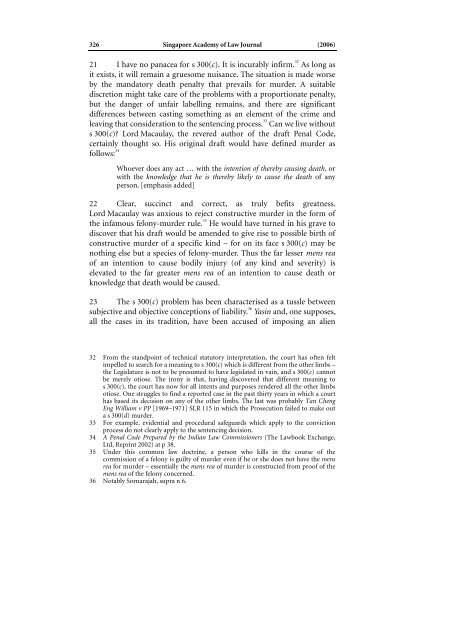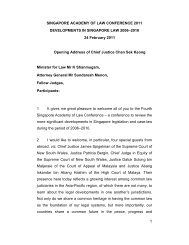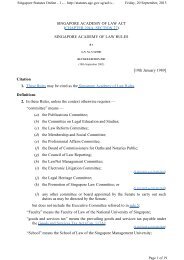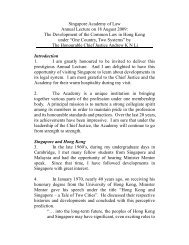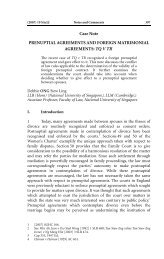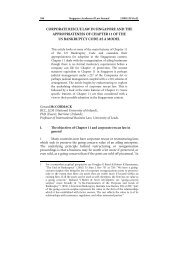18 SAcLJ 314 <strong>Manag<strong>in</strong>g</strong> <strong>Mens</strong> <strong>Rea</strong> <strong>in</strong> S<strong>in</strong>gapore 325m<strong>in</strong>ded, judges have seized upon an <strong>in</strong>herent ambiguity <strong>in</strong> s 300(c) –death occurs through a cha<strong>in</strong> <strong>of</strong> events and s 300(c) does not tell usexactly how far along that cha<strong>in</strong> the <strong>in</strong>tention <strong>of</strong> the accused must extend.So, another criterion has to be found, and the only <strong>in</strong>st<strong>in</strong>ctive and ethicalone is none other than knowledge <strong>of</strong> lethality. 29 In short, s 300(c) can beconsistent and fair only if the judges work <strong>in</strong> an implicit calculation <strong>of</strong>knowledge <strong>of</strong> likelihood <strong>of</strong> death, but if that is done, the rationale fors 300(c) disappears, for the rema<strong>in</strong><strong>in</strong>g limbs <strong>of</strong> murder can now do thejob just as well. There have been attempts to make s 300(c) mean<strong>in</strong>gfuland more palatable – notably, it has been suggested that it embodies arequirement that a serious <strong>in</strong>jury must have been <strong>in</strong>tended. 30 That is betterthan just any <strong>in</strong>jury – for the more serious the <strong>in</strong>jury, the more likely it isthat the accused would have known that death might ensue. But this hasbeen repeatedly denied by Virsa S<strong>in</strong>gh and almost every decision s<strong>in</strong>ce.More importantly, the requirement <strong>of</strong> a “serious <strong>in</strong>jury” itself conta<strong>in</strong>s an<strong>in</strong>herent ambiguity – how is seriousness to be measured? One only needsto look at the list which dist<strong>in</strong>guishes hurt from grievous hurt 31 – it wouldbe an open <strong>in</strong>vitation to argue <strong>in</strong>term<strong>in</strong>ably about how the list, for thepurpose <strong>of</strong> murder, is too narrow or too broad. Even more significantly,the only mean<strong>in</strong>gful and ethical way <strong>of</strong> decid<strong>in</strong>g when serious is seriousenough is, aga<strong>in</strong>, to work <strong>in</strong> a criterion <strong>of</strong> knowledge <strong>of</strong> likelihood <strong>of</strong>death – a serious <strong>in</strong>jury is one which the accused knows is likely to causedeath. It could <strong>of</strong> course be an objective criterion – a serious <strong>in</strong>jury canbe that which is objectively likely to lead to death, but would render theproposed <strong>in</strong>tention to cause serious <strong>in</strong>jury the same as the exist<strong>in</strong>g<strong>in</strong>tention to cause any <strong>in</strong>jury.29 It is possible that some time <strong>in</strong> the future this k<strong>in</strong>d <strong>of</strong> situation will give rise toproblems <strong>of</strong> constitutional due process under Art 9 <strong>of</strong> the Constitution <strong>of</strong> theRepublic <strong>of</strong> S<strong>in</strong>gapore because <strong>of</strong> a disproportionality between the crime (s 300(c)murder) and the punishment (mandatory death), and <strong>of</strong> constitutional <strong>in</strong>equalityunder Art 12 because s 300(c) murder is so qualitatively different from ss 300(a), (b)and (d), that it would be unjustifiably arbitrary to lump them all together for thepurpose <strong>of</strong> conviction and punishment. It is too early to predict if this will come topass, but foreign precedents are not hard to f<strong>in</strong>d: for example, the Supreme Court <strong>of</strong>Canada <strong>in</strong> R v Mart<strong>in</strong>eau [1990] 2 SCR 633 declared that pr<strong>in</strong>ciples <strong>of</strong> fundamentaljustice required a m<strong>in</strong>imum mens rea <strong>of</strong> subjective foresight <strong>of</strong> death for a murderconviction. I have elsewhere described a possibly nascent rule <strong>of</strong> customary<strong>in</strong>ternational law requir<strong>in</strong>g a “most serious” crime to justify the imposition <strong>of</strong> thedeath penalty: Michael Hor, “The Death Penalty <strong>in</strong> S<strong>in</strong>gapore and International<strong>Law</strong>” (2004) 8 SYBIL 105.30 Notably by Ramraj, supra n 6.31 Section 320, Penal Code. For example, “fracture or dislocation <strong>of</strong> a bone” turns hurt<strong>in</strong>to grievous hurt, but there is no way <strong>of</strong> predict<strong>in</strong>g if an <strong>in</strong>tention to fracture a boneis an <strong>in</strong>tention to cause a serious enough <strong>in</strong>jury to attract s 300(c) without add<strong>in</strong>g acriterion <strong>of</strong> knowledge <strong>of</strong> likelihood <strong>of</strong> death.
326S<strong>in</strong>gapore <strong>Academy</strong> <strong>of</strong> <strong>Law</strong> Journal (2006)21 I have no panacea for s 300(c). It is <strong>in</strong>curably <strong>in</strong>firm. 32 As long asit exists, it will rema<strong>in</strong> a gruesome nuisance. The situation is made worseby the mandatory death penalty that prevails for murder. A suitablediscretion might take care <strong>of</strong> the problems with a proportionate penalty,but the danger <strong>of</strong> unfair labell<strong>in</strong>g rema<strong>in</strong>s, and there are significantdifferences between cast<strong>in</strong>g someth<strong>in</strong>g as an element <strong>of</strong> the crime andleav<strong>in</strong>g that consideration to the sentenc<strong>in</strong>g process. 33 Can we live withouts 300(c)? Lord Macaulay, the revered author <strong>of</strong> the draft Penal Code,certa<strong>in</strong>ly thought so. His orig<strong>in</strong>al draft would have def<strong>in</strong>ed murder asfollows: 34 Whoever does any act … with the <strong>in</strong>tention <strong>of</strong> thereby caus<strong>in</strong>g death, orwith the knowledge that he is thereby likely to cause the death <strong>of</strong> anyperson. [emphasis added]22 Clear, succ<strong>in</strong>ct and correct, as truly befits greatness.Lord Macaulay was anxious to reject constructive murder <strong>in</strong> the form <strong>of</strong>the <strong>in</strong>famous felony-murder rule. 35 He would have turned <strong>in</strong> his grave todiscover that his draft would be amended to give rise to possible birth <strong>of</strong>constructive murder <strong>of</strong> a specific k<strong>in</strong>d – for on its face s 300(c) may benoth<strong>in</strong>g else but a species <strong>of</strong> felony-murder. Thus the far lesser mens rea<strong>of</strong> an <strong>in</strong>tention to cause bodily <strong>in</strong>jury (<strong>of</strong> any k<strong>in</strong>d and severity) iselevated to the far greater mens rea <strong>of</strong> an <strong>in</strong>tention to cause death orknowledge that death would be caused.23 The s 300(c) problem has been characterised as a tussle betweensubjective and objective conceptions <strong>of</strong> liability. 36 Yas<strong>in</strong> and, one supposes,all the cases <strong>in</strong> its tradition, have been accused <strong>of</strong> impos<strong>in</strong>g an alien32 From the standpo<strong>in</strong>t <strong>of</strong> technical statutory <strong>in</strong>terpretation, the court has <strong>of</strong>ten feltimpelled to search for a mean<strong>in</strong>g to s 300(c) which is different from the other limbs –the Legislature is not to be presumed to have legislated <strong>in</strong> va<strong>in</strong>, and s 300(c) cannotbe merely otiose. The irony is that, hav<strong>in</strong>g discovered that different mean<strong>in</strong>g tos 300(c), the court has now for all <strong>in</strong>tents and purposes rendered all the other limbsotiose. One struggles to f<strong>in</strong>d a reported case <strong>in</strong> the past thirty years <strong>in</strong> which a courthas based its decision on any <strong>of</strong> the other limbs. The last was probably Tan ChengEng William v PP [1969–1971] SLR 115 <strong>in</strong> which the Prosecution failed to make outa s 300(d) murder.33 For example, evidential and procedural safeguards which apply to the convictionprocess do not clearly apply to the sentenc<strong>in</strong>g decision.34 A Penal Code Prepared by the Indian <strong>Law</strong> Commissioners (The <strong>Law</strong>book Exchange,Ltd, Repr<strong>in</strong>t 2002) at p 38.35 Under this common law doctr<strong>in</strong>e, a person who kills <strong>in</strong> the course <strong>of</strong> thecommission <strong>of</strong> a felony is guilty <strong>of</strong> murder even if he or she does not have the mensrea for murder – essentially the mens rea <strong>of</strong> murder is constructed from pro<strong>of</strong> <strong>of</strong> themens rea <strong>of</strong> the felony concerned.36 Notably Sornarajah, supra n 6.


